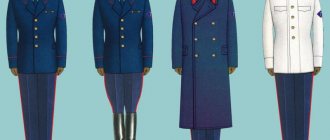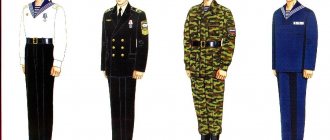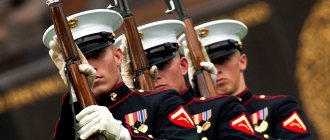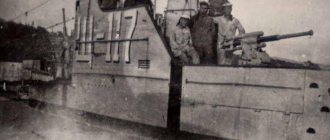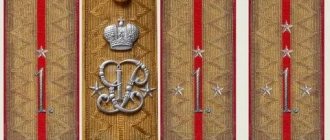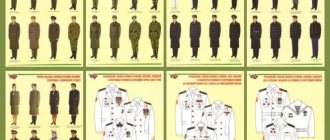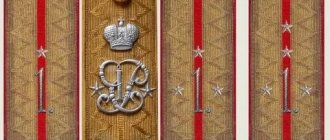Border troops
Russian border troops are not included in the Armed Forces.
They belong to the Federal Security Service (FSB). This is due to the fact that the task of border guards is to protect the borders of the state, and the likelihood of provocation here is much higher than within the country.
The concept of boundaries is not limited to geographical boundaries. Checkpoints at air and sea ports, regardless of location, are also guarded by border troops.
The main duty of the border troops is to identify border violators and prevent them from entering the country illegally. Due to the increased terrorist threat and the tense global political situation, the responsibility of border guards and the moral and psychological burden on them have also increased.
In view of this, very stringent requirements are imposed on candidates undergoing selection.
The uniform of the border guards has undergone constant changes since the formation of the troops. This is due to the fact that the uniform of representatives of the air control department at the airport, of course, will differ from the uniform of the outpost detachment.
Weather conditions in the country also differ. The main requirement for clothing is comfort and convenience, so that a person feels free both during normal workdays and in unusual cases at the border (for example, when chasing a violator).
The uniform of border guards has been constantly improved, and today it has the proper appearance and makes it possible to fully perform official duties.
The number of vacancies in the border troops is significantly less than the number of people willing to join the service, since it is not only prestigious, but also provides many privileges, which include the following:
- Proper working conditions.
- Early retirement, various benefits.
- Medical care at public expense.
- Possibility of paid holidays in FSB dispensaries.
- Payment of sick leave.
- Opportunity to take out a mortgage on preferential terms.
- Increases for more than five years of service.
Current positions and salaries for service in the border troops on a contract basis are as follows:
- Rank and file employee (salary 35-45 thousand rubles).
- Non-commissioned officer (36-45 thousand rubles).
- Radio operator (36 thousand rubles).
- Guard service specialist (36 thousand rubles, determined by the region of service).
- Driver (37 thousand rubles).
- Specialist in the field of security of objects (41-46 thousand rubles).
- Dog handler (45 thousand rubles).
- Cook (45-50 t.r.).
- Security officer (salary up to 70 thousand rubles).
Women can apply for the vacancy of a senior investigator at airports, an air control officer (salary from 40,000 rubles).
Border region employees are most often needed in regions such as Kursk, Murmansk, and Kaliningrad. Bryansk, Rostov, Pskov, Orenburg regions, Primorsky, Perm territories, the Republic of Karelia and the Republic of Sakha.
Those wishing to serve in the border troops of the Russian Federation must prepare themselves in advance that in order to successfully pass all tests they need to constantly work on the level of their mental abilities and physical abilities.
In order to move from a warrant officer to an officer, and then reach a general, you need to increase the level of education in specialized FSB institutes. It is also advisable to additionally study foreign languages.
Today, according to the Ministry of Defense of the Russian Federation, approximately 150 thousand people perform border service on a contract basis. Military personnel responsible for maintaining the country's borders largely ensure peace of mind for its citizens.
Historical standards
According to historical standards for how to sew a chevron on a sleeve, the type of location and type of it were prescribed differently in each unit. For example, the crossed anchor of the navy was usually sewn on the left sleeve, a shield with the image of the Russian flag and the coat of arms of the ground forces was placed on the left and right sleeves. General field uniform patches were placed on the left.
Chevrons on sleeves
At the moment, there are non-standardized rules that prescribe how the chevrons should be located. They indicate information on how the stripes should be located and where to sew them. However, some private enterprises change the rules for their own reasons. There are no uniform requirements for the shape and how to properly sew chevrons and at what distance.
Various legislative acts contain only some information about the appearance of a person while performing official duties. Such documents indicate that the appearance should emphasize the status of the object.
Historical location
Rules for wearing uniforms by employees of the Ministry of Internal Affairs
The police are practically the internal army of Russia with all the ensuing consequences. Namely, strict chain of command, military ranks and a special code of honor.
Wearing uniforms is one of the main differences between employees of the Ministry of Internal Affairs. Police and traffic police officers have strict regulations regarding official clothing, violation of which is subject to penalties.
Types of uniforms and insignia are regulated by Order of the Ministry of Internal Affairs No. 575 of July 26, 2013, as well as by Decree of the Government of the Russian Federation No. 853. The uniform has a certain variety of colors and styles, but the wearing and combination of various parts of the wardrobe has clear instructions that cannot be violated. Next, we will talk about how to wear the Ministry of Internal Affairs uniform and how to properly attach awards to it.
Types of uniforms
The uniforms of the Ministry of Internal Affairs are made from gray or blue-gray fabric. There are summer, winter and demi-season sets. Chevrons, shoulder straps and other insignia corresponding to the rank are sewn onto the uniform.
Wearing rules are strictly regulated. In addition to clear instructions, the government regulations contain images that clearly demonstrate the order and location of all distinctive signs. In addition, there is an instruction that uniforms must be kept clean, ironed and fit properly.
There are several types of form:
- Casual. Used every day.
- Special. For special assignments.
- For service on the street. Used for cordons and other special operations.
- Day off. Worn for the oath, parades and on guard duty.
Each type of uniform has both a summer and a winter version. The transition between winter/summer occurs simultaneously throughout the entire territory of the Russian Federation, regardless of the climate zone.
Interestingly, the uniform cannot be worn outside of duty. If a law enforcement officer is seen dressed in uniform in an entertainment establishment, he will most likely be punished. In addition, women are prohibited from wearing too bright makeup and flashy jewelry.
How to wear a uniform
The Ministry of the Interior has developed strict rules that regulate all aspects of wearing uniforms. For example, you cannot wear earflaps with an autumn jacket, or a summer headdress with a winter pea coat.
This also applies to the combination of elements belonging to different types of form. That is, a dress jacket cannot be worn with casual trousers, and a winter hat cannot be worn with a summer T-shirt, etc.
Rules for wearing the uniform:
- Shoes must be black. Women are allowed to wear low heels.
- The cap is worn so that the visor is slightly tilted to the right and is at eyebrow level. The earflaps cannot be more than 20-30 mm below the eyebrows.
- Uniforms must be buttoned all the way to the top.
- Trousers should only be tucked into high boots or boots.
- If it's hot, it's okay to roll up your sleeves a little.
- The skirt cannot be above or below the knee.
- The shirt comes with a tie, which you don’t have to wear in the summer.
These are not all the rules that the government has developed for police uniforms. The full list can be found in the official government regulations.
Rules for attaching insignia
The new regulations stipulate not only the rules for wearing clothes, but also how and where to attach chevrons, shoulder straps and other insignia. Let us note that by order of the Ministry of Internal Affairs, wearing insignia is mandatory, and there are also strict regulations in this regard:
- Shoulder straps must be on shirts and all outerwear. They can either be sewn on or attached with Velcro.
- The standard size of insignia is 12x7.5 cm.
- The inscription "Police" is located at the top left, as well as in large letters on the back.
- Special identifying marks are attached to the left pocket. If strips are used, they are placed 1 cm below the left pocket.
- Awards are attached to the left, observing the hierarchy.
All insignia are attached so that there are gaps of a certain size between them. For example, for signs of the Ministry of Internal Affairs of the Russian Federation it is 5 cm.
Conclusion
That's all the basic rules for wearing the uniform of the Ministry of Internal Affairs. Of course, we talked about this in a condensed form. If we list all the intricacies of wearing a uniform and insignia, the article will turn out to be several pages long. If you are interested in this topic, study the official document on the Ministry of Internal Affairs website.
Ensign's shoulder straps, correct placement of stars
By the way, chevrons on a shirt can also be made with Velcro. Naturally, since the chevrons are light, white Velcro is sewn on.
How to attach shoulder straps with insignia to a shirt? There are several ways to do this:
- Clip. First, the insignia and coat hangers are ironed. This is necessary so that the shoulder straps fit more tightly onto the shirt. Then the form element is placed on the shoulder, a button is inserted into the hole on it and a paper clip is threaded into its eye. It securely holds the shoulder strap in its place.
- Pin. This method is not very reliable. The insignia fixed with a pin is constantly shifting. Before attaching a button to the shoulder straps, the pin has to be bent so that it holds them better. This leads to the fact that the fasteners often open up.
- Match. This method is not described in the regulations. However, it is often used due to its simplicity. In this case, the match is threaded into the leg of the button, replacing a pin or paper clip. The method is not very reliable - a piece of wood can break at any moment.
- Clamp for fastening buttons on shoulder straps. A match, pin or paper clip can be replaced when attaching a shoulder strap with a special device. This is a metal plate with cutouts in its center. Such a clamp is threaded into the eye of the button and thereby secures the shoulder strap on the hanger of the garment.
While sewing, pay attention to the lining of the mold. The needle must be threaded into the outer fabric so that it does not catch the inner one. Otherwise, the fabric will wrinkle. Medals of the Ministry of Internal Affairs of Russia, intended to be worn on blocks, are placed horizontally in a row from left to right, from top to bottom in the order listed above. When wearing two or more medals, their blocks are connected in a row on a common bar. In this case, no more than five medals (including state awards) can be placed on one common bar.
Now let's move on to the chevrons, which are sewn as before on the sleeves of a tunic, a short-sleeved jacket, a winter jacket or a peacoat, and now also on the sleeves of a shirt (both with long and short sleeves; the chevrons themselves are blue or white) . I would also like to note that a small innovation has been added - chevrons can be made with Velcro.
In 2011, the government of the Russian Federation issued Resolution No. 835, which talks about the features of official clothing for men and women, the distinctive features of the components of the uniform depending on rank and position, provides a definition of the uniform, and a description of the types of shoulder straps.
The purpose of these rules is to increase the prestige of service in the internal affairs bodies and respect in society for police officers. In addition, form, as you know, disciplines.
The distance between the badges is 0.5 centimeters, they are located from left to right in horizontal stripes.
New form for obtaining a foreign passport for 5 years
In 2022, fill out the necessary new application form prepared by the Ministry of Internal Affairs and approved by Order No. 864 of November 16, 2017.
Annex 1 to the said order contains the current application for filing in 2022.
Unlike the previously valid forms, the new form is the same for both the old sample international passport and the new biometric one.
When filling out, a citizen just needs to tick the required type of passport; the lines are completed in an identical manner.
A separate application form has been developed for minors; it must be filled out for a child under 18 years of age by a parent, adoptive parent, guardian or trustee.
Where to get?
The new form can also be found on the official website of the Russian Ministry of Internal Affairs, where it is presented as Appendix 1.
It is possible to personally visit the place where documents are submitted and take a paper version of the application for subsequent completion and delivery to the destination.
The electronic method of submitting documents through the Government Services Portal will help eliminate errors when choosing the current form.
Where to submit?
The service for issuing foreign passports to the population is provided by the Ministry of Internal Affairs of the Russian Federation, as well as its migration divisions.
In general, citizens of the Russian Federation have several ways to submit documents for a new generation passport:
- submit the papers in person to the Main Directorate for Migration of the Ministry of Internal Affairs of Russia;
- bring them to the nearest territorial department of the Ministry of Internal Affairs, which deals with migration issues;
- MFC – multifunctional center;
- electronically through the government services website.
Upon receipt from a citizen of an application and other documents for a new generation international passport, the responsible authority either issues a foreign passport of the established form or draws up a notice of refusal.
Dates of issue
The period for obtaining a new foreign biometric document depends on the place of submission and should not exceed:
- at place of residence – 1 month;
- at the place of stay - 4 months;
- for applicants with access to particularly important information – 3 months;
- in special cases (serious illness, emergency treatment, death of a relative), if these circumstances require traveling abroad, the period is no more than 3 working days.
This duration is established both for cases of submitting documents to branches of the Ministry of Internal Affairs of Russia, and to the MFC or through the Unified Portal of Public Services.
What is a chevron?
A chevron or braid is a distinctive sign that allows you to identify a person by type of military service, his rank or unit.
Nowadays they call it any sleeve or chest patch, but this is wrong. The patch is used by security organizations and various government agencies.
Chevrons are a V-shaped patch. They are made from braid or braided cord. Embroidery denotes a title or award. Often used to refer to students of military educational institutions.
Signs are indicated in a strictly defined form. Patches can come in many different shapes and types. They can be round, square or rectangular in shape. They are usually associated with employees of the Ministry of Internal Affairs and military personnel. Stripes are a badge of rank that carries information about any branch of the military to which the employee belongs, and also denotes rank.
The structure, which is located on the territory of the state, has individual symbols and images.
Sleeve insignia on clothing should be located at a length of 8 cm from the top edge of the insignia to the seam of the left sleeve. All rules are regulated by law, both for men and women. Embroidery must be installed on weekend and everyday uniforms.
The evolution of uniforms - comfort and new technologies
Fashion does not stand still even in the industry of workwear for employees in government departments. Over the centuries, old uniforms were replaced by new ones, the material from which uniforms were made changed, and accessories were added.
An excellent everyday uniform is sewn for them, which does not at all spoil the beautiful half of humanity serving in the Ministry of Internal Affairs, but on the contrary:
- comfortable;
- practical;
- betrays efficiency.
Designers developing different types of workwear try to make it even better every time. Most recently, in 2014, the uniforms of the canine service workers were completely updated. The Deputy Minister of Internal Affairs informed employees of the Ministry of Internal Affairs of the Russian Federation that they had received funds from the budget for the purchase of a new uniform, which was approved by the President of Russia after a presentation of samples.
The efforts of the designers were not in vain; the uniform really has:
- High-tech.
- Convenience.
- Comfort.
For example, a special material has a membrane coating that allows the clothing to “breathe” and, in addition, it repels moisture. Windproof uniforms are made from it. This type of clothing will last for a long period of time. Civil servants received additions to their basic workwear, these are:
- baseball caps instead of caps;
- warm sweaters;
- jumper.
Testing of new models of the Ministry of Internal Affairs uniform was carried out not only in Omsk, but also in 11 other units of the Russian internal troops. Everyone was satisfied with the result, and the comfort when wearing the uniform was noted.
Types of shoulder straps in the Russian police
Before attaching the shoulder strap, stars and other insignia should be installed in their places in a clear sequence.
This document regulates the procedure that should be followed when wearing uniforms by employees of the Ministry of Internal Affairs.
Gold-colored stars are intended primarily for formal wear. Gray ones are considered more casual, so they are attached to the field uniform. However, for such cases, false shoulder straps are designed, which completely eliminate the possibility of losing stars, because they are sewn into the material.
The number of gaps and the size of the stars on the shoulder elements indicate whether the military officer belongs to the junior or senior rank of officers.
Features of wearing a police uniform in Russia
According to the order of the Government of the Russian Federation, employees of the Ministry of Internal Affairs will serve in new uniforms. Since the old clothes no longer meet modern requirements, the Government decided to change the uniform. The new type of overalls should help in the fight against scammers who disguise themselves as police officers.
Also, employees of the Ministry of Internal Affairs are required to know about the rules for wearing, combining uniforms and accessories for them. This ensures unity and harmony in the ranks dressed in police uniforms during a general inspection.
A person entering the service of the Ministry of Internal Affairs is issued several sets of special clothing corresponding to the type of service, season, and gender of the employee.
An example would be a situation where a person retires to a well-deserved pension. A former employee does not lose the right to wear a uniform on any occasion convenient for him. Uniform accessories must comply with established standards, be in good working order, and neat. There are special clothes for certain occasions:
- festive uniforms are worn at special events, this could be an event associated with taking an oath, guard of honor, or award;
- casual uniform is used to perform work duties;
- special clothing worn by police officers for particularly important special assignments;
- service uniform for external service, for employees of teaching staff, traffic police.
The rules clearly define accessories that go with the uniform. All employees of the Ministry of Internal Affairs must comply with regulations when wearing uniforms. The government issued Resolution No. 835 defining the features of men's and women's workwear. It depends on the:
- position held;
- assigned rank.
A definition of uniform is also given, and types of shoulder straps are described. The resolution establishes the standard by which employees of the Ministry of Internal Affairs are supplied with special clothing in peacetime.
INDICATORS ON THE POLICE COAT DISTANCE PHOTO
If you sew the chevrons yourself, then first measure the distance from the shoulder (the same 8 cm), approximately position the chevron exactly vertically under the shoulder strap and grab it at the upper corners with thread. Then put on the shirt and see how the chevron on the sleeve looks, you may have to move it a little to the left or right.
The Russian Ministry of Defense has developed special Regulations that spell out how to correctly attach stars to shoulder insignia. There is also an order of the Ministry of Internal Affairs that establishes this procedure. Strict compliance with the norms of these acts is mandatory for all persons who devote themselves to service in the army or other law enforcement agencies.
One of the signs symbolizes belonging to the Russian Ministry of Internal Affairs. It is sewn onto the left sleeve exactly 80 mm below the shoulder. The sign is made in the form of a triangular shield, its upper edge is rounded, the inscription “Ministry of Internal Affairs” is located below, and “POLICE” is written above the shield.
It is the placement pattern and the number of stars that provide comprehensive information about the position a person occupies.
Video
MINISTRY OF INTERNAL AFFAIRS OF THE RUSSIAN FEDERATIONORDER of June 8, 2001 N 575 ABOUT ANNOUNCEMENT OF THE DAY OF ECONOMIC SERVICE OF THE INTERNAL AFFAIRS BODIES OF THE RUSSIAN FEDERATIONBy decision of the Executive Committee of the Petrograd Soviet on July 18, 1918, the central, district and subdistrict Committees revolutionary guards were transformed into the Commandant's Offices of the revolutionary guards, which included the economic Department. It consisted of subsections: weapons, uniforms, automobile, food, supplies. For more than 80 years of activity of the internal affairs bodies of the Russian Federation, economic units have come a long way in their formation and development from units scattered across individual services to a coherent economic system. Today, business units are a complex multilateral service that provides production, economic, social, logistical and motor transport support to the central apparatus of the Ministry of Internal Affairs of Russia, bodies and divisions of internal affairs of the Russian Federation. In the new economic conditions, the role of business workers is increasing, appropriate work methods are being developed that make it possible to respond in a timely manner to changes in the socio-economic situation at the federal and regional levels, and to actively participate in the material, economic, social and welfare support of the internal affairs bodies of the Russian Federation. Taking into account the increased role of economic units, in order to increase the prestige of economic work, promote the accumulated experience and established service traditions, I order: 1. Consider July 18, 1918 as the date of the creation of the economic service of the internal affairs bodies of the Russian Federation. 2. Declare July 18 as the Day of Economic Service of the Ministry of Internal Affairs of the Russian Federation. 3. The heads of the main departments and directorates of the Ministry of Internal Affairs of Russia, the ministers of internal affairs, the heads of the Main Internal Affairs Directorate, the Internal Affairs Directorate of the constituent entities of the Russian Federation, the heads of the Internal Affairs Directorate, the Internal Affairs Directorate (OVD) of the URO of the Ministry of Internal Affairs of Russia, the heads of educational and research institutions of the Ministry of Internal Affairs of Russia, in accordance with the established procedure, annually celebrate Economic Service Day Ministry of Internal Affairs of the Russian Federation, to encourage particularly distinguished employees and workers of this service. Minister B. GRYZLOV
At the end of 2011, an elegant new form was approved in Russia
. In accordance with the Decree of the Government of the Russian Federation, employees of the Ministry of Internal Affairs were to serve there.
This was the right step due to the fact that the old uniform was hopelessly outdated and did not harmonize with modern clothing requirements.
The new form has become practical and consistent with the principles of convenience and modernity.
.
An employee of the Ministry of Internal Affairs must know how to wear and combine the uniform and its elements correctly. This will ensure uniformity and order in the ranks of uniformed police officers, and will also help protect against fraudsters who commit crimes masquerading as servants of the law.
Sew a chevron onto a pea coat
Now let's take a closer look at how to sew a chevron onto a pea coat. The main requirement remains unchanged - it is sewn at a distance of eight centimeters from the edge of the shoulder. For example, on a police peacoat, a chevron of the military branch is sewn onto the left sleeve, and a chevron denoting the service of a police officer (OPP, transport police, private security, traffic police, and so on) is sewn onto the right sleeve. The threads are matched to the color of the pea coat. It is also worth remembering that stitching a peacoat with a needle will be a little more difficult than the thin fabric of a uniform shirt
Therefore, it is important that the chevron does not move during operation. To do this, you can make four bastings, attaching it to the sleeve, and then undo them
You can also use pins (but they may get in the way during the sewing process). Or you can go the very simple route - buy a chevron with Velcro. However, it is worth considering that it is also better to sew it on, because as a result, due to weather conditions and active movement, the Velcro can weaken, and the chevron simply gets lost. So, we learned how to sew a chevron onto a peacoat.
New uniform of the Ministry of Internal Affairs of Russia
The old model of the police uniform lasted sixteen years. In appearance, the former uniform remained almost unchanged. The new uniform was developed over several years and tested in twelve regions with different climatic conditions. Costume specialists from Mosfilm and the famous fashion designer I. Chapurin participated in the creation of the workwear.
The old dark gray police uniform has now been replaced with a new, smart dark blue uniform. For example, wardrobe items:
- Trousers.
- Skirts.
- Jacket.
They are made from lightweight worsted material, which contains a high percentage of wool and lycra, which allows the suits not to wrinkle. The summer uniform is made of breathable fabric.
The shoes were also designed for each season. Genuine leather is used for its production. Women are provided with a heel with a height of 4.5 cm. Special forces, police and traffic police officers were also given improved shoes using special materials.
Features of the form and its distinctive elements
Shoulder straps are attached to the uniforms of some government agencies using turnstile buttons. In this case, a rounded part with a bolt, riveted to the shoulder strap (“folder”) is inserted into an element with a recess (“mother”) attached to the hanger of the garment. The button then snaps into place. That is, the rivet consists of two steel elements that fit into one another.
There is no need to think about how to attach rivets to uniforms. It is completed with these elements in sewing shops.
Aesthetic requirements for form are difficult to establish, since this is difficult to prescribe at the level of a regulatory act. The purpose of transforming workwear is to make the appearance of law enforcement officers respectable and prestigious, inspiring confidence among citizens.
The first step is to determine the location. The shoulder strap must be placed in such a way that its outer side is close to the shoulder seam. The insignia is fixed along it. The longitudinal sides of the form element should deviate from the edges of the garment hanger by 1 cm. Otherwise, the shoulder strap will hang forward or backward.
So, first you should grab the shoulder straps with auxiliary stitches. Instead, you can use needles for fixation. Having placed the part correctly, you can begin to carefully sew it on. At the end, the thread is discreetly cut and fixed. It is important to remember that all metal insignia and buttons must be sewn on before the product is fixed on the shoulder of the tunic or coat.
Classification of special purpose units
Existing special forces units in Russia belong to different departments. The Russian Armed Forces have the following special forces units:
- Ground Forces (ground forces) - DShB brigades and DShP regiment;
- GU - 25th regiment and brigade;
- MO – center of Senezh;
- GRU - PDSS detachments of reconnaissance points Parusnoye (Baltic Fleet), Tuapse (Black Sea Fleet), Zverosovkhoz (Northern Fleet) and Fr. Russky/Dzhigit Bay (Pacific Fleet);
- Airborne Forces - 45th Guards Brigade (Kubinka);
- Navy - detachments of the Caspian Flotilla, Black Sea, Baltic, Pacific and Northern Fleet.
The Russian special services also have special forces units:
- FSB - operational support departments, regional departments and services, departments A (Alpha), B (Vympel) and C;
- Border Service of the FSB - regional services and departments, DShM of border detachments, special intelligence groups OGSpR;
- SVR – Zaslon detachment;
- Ministry of Internal Affairs - Thunder squad;
- National Guard troops - instead of internal troops, detachments were created: Wolverine (Krasnoyarsk-26), Rus (Simferopol), Skif (Grozny), Peresvet (Moscow), Svyatogor (Stavropol), Bulat (Ufa), Ratnik (Arkhangelsk), Kuzbass (Kemerovo) , Bars (Kazan), Mercury (Smolensk), Mechel (Chelyabinsk), Typhoon (Khabarovsk), Ermak (Novosibirsk), Edelweiss (Minvody), Vyatich (Armavir), Ural (Nizhny Tagil), Rosich (Novocherkassk), 604 TsSN;
- Rosgvardia - combat units of SOBR and OMON;
- FSIN - republican departments Saturn (Moscow), Rossy (Sverdlovsk), Typhoon (Lenoblast), Iceberg (Murmansk), Guardian (Chuvashia), Akula (Krasnodar), Yastreb (Mari El), Vulcan (Kabardino-Balkaria);
- Ministry of Emergency Situations – special risk center Leader;
- FSUE Communications-Security – Mars department.
Some of the above special purpose units are military, that is, by default they are staffed by military personnel. The other is departmental, that is, it employs employees who are assigned special ranks, not military ones. The two largest ministries of the Russian Federation include both:
- Ministry of Internal Affairs - the special forces of the National Guard are staffed by military personnel, riot police and special forces are not military formations;
- FSB - special forces of the border troops and departments A, B and C, respectively.
Special forces units carry out combat missions in populated areas and forests, under water and in the air, so field uniforms, ammunition and weapons are very different. A presidential decree in 2005 prohibited the use of insignia and military uniforms in the security units of the FSB, FSKN, Ministry of Internal Affairs, FSIN, PPS and other departments formed not from military personnel.
A little history
In the 17th century, the Tsar of the Moscow State Alexei Mikhailovich “The Quietest” transferred the Robbery Order, which dealt with investigation, inquiry and trial, to the Zemsky Prikaz, essentially the local authorities. The first police officers of the state were called zemstvo yaryshki, their methods of work were simple, they did not stand on ceremony with the guilty or the innocent for a long time, which earned them unpleasant nicknames. Since then, the people's dislike for the police has been established.
The outerwear of the first law enforcement officers was green, with embroidered red patches with the letters “Z” and “I” on the front shelves. The official clothing of Russian law enforcement officers at that time was different from European ones; until the 18th-19th centuries, their uniforms had a gloomy appearance, while our employees dressed brightly.
Peter I issued a decree according to which a real police force was founded in 1718. The king took responsibility for every little detail, so he personally set the uniform. The first police suit consisted of:
- cornflower blue caftan;
- trousers and a cap of the same shade;
- green camisole;
- black tie;
- The cuffs, cap and fur on the uniform were red.
Until the reign of Catherine II, uniforms remained unchanged. The year 1775 was marked by two acts of the Tsarina, thanks to them, uniforms were changed and the foundation of police power was laid.
The first act is “Institution for governing the province”, the second is “Charter of the deanery or police”. As a result, a police structure emerged that remained virtually unchanged until the 19th century. As the created decree stated, the uniform included:
- a cloth caftan with tailored tails and collar;
- vest or camisole;
- tricorn hat;
- pantaloons;
- shoes and stockings; for equestrian service they were replaced with over-the-knee boots.
The weapon at that time was the sword. Each province also had its own uniform color:
- Employees of St. Petersburg and the northern regions wore light blue service clothes.
- Employees of Moscow and nearby provinces were in red uniforms.
- Kyiv policemen and employees of the southern regions were issued dark cherry uniforms.
Paul I made his own changes, in particular, the army was separated from the police institution, and therefore a badge was added to the existing uniform, which depicted a double-headed eagle and indicated the position of the owner. A little time passed and in 1808 the uniforms of the officials of the Ministry of Internal Affairs of Tsarist Russia were updated.
The Ministry received:
- dress uniform;
- everyday uniform.
The cut of the suits was similar to each other. These were dark green coats with high collars, black velvet cuffs, and yellow metal buttons.
Until 1917, police uniforms changed more than once and new elements were added to them. The Bolshevik coup that took place ended the two-hundred-year history of the Russian police. But since the crime situation was heating up, the new government had to create volunteer detachments to patrol the city streets. The Workers' and Peasants' Militia was formed in 1917 and existed until the collapse of the USSR.
https://youtube.com/watch?v=IhSU0C02v-Y




